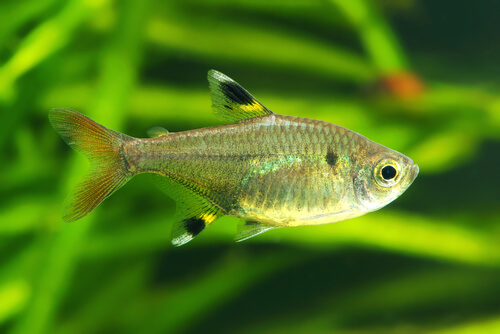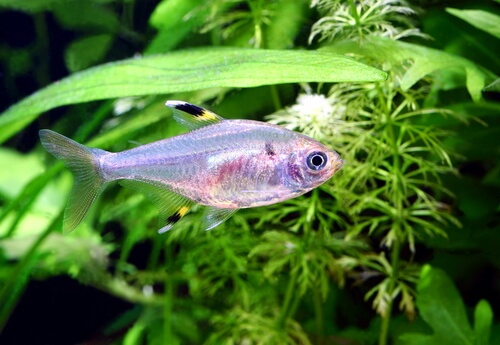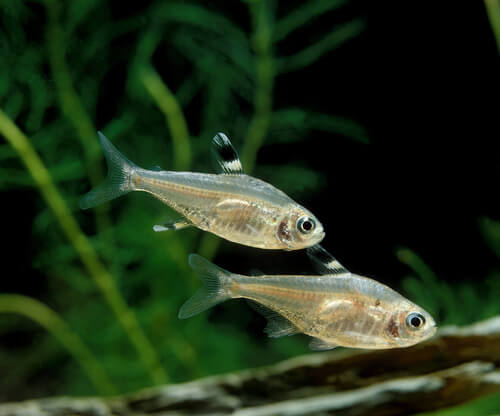
| Kingdom | Animalia |
| Phylum | Chordata |
| Class | Actinopterygii |
| Order | Characiformes |
| Family | Characidae |
| Genus | Pristella |
| Species | P. maxillaris |
| Niche | Aquatic fish |
| Length | 1.6-1.9 in (3.2-5 cm) |
| Lifespan | 2-5 years |
| Social Structure | Schooling |
| Conservation Status | Not listed (common) |
| Preferred Habitat | Freshwater ponds and lakes in South America |
| Average Spawn Size | 350 |
| Main Prey Species | Worms, insects, small crustaceans |
| Predators | Larger fish |
The Basics
The X-Ray Fish is a small schooling aquatic fish native to the Amazon basin in South America. Also known as the Golden Pristella Tetra, X-Ray Tetra, and Water Goldfinch, they are known for their translucent skin that allows their organs and skeleton to be observed, much like an X-Ray.
Description
The X-Ray Fish is small, growing to a maximum of 1.9 inches, with females slightly larger than males. It is a silvery-yellow color with striking black, white, and yellow stripes on its dorsal and anal fins. Its skin is translucent, allowing for its bony internal structure to be observed.
Although the only member of its genus, the X-ray fish is closely related to some 100 other Tetra species native to South America. In addition, it is one of the most popular freshwater aquarium species globally.

Distribution and Habitat
The X-Ray fish is native to the coastal Amazon regions of Brazil, Guyana, and Venezuela. They are distinct from most other tetras in their ability to tolerate the brackish waters in this region. However, they are also able to thrive in more typical freshwater environments, normally in streams and tributaries during the dry season and into flooded marshlands during the rainy season.
Diet and Predators
The X-Ray fish is omnivorous, feeding on a wide variety of animals and plants. Various small species of worms, aquatic insects and their larvae, and small shrimp-like animals are commonly hunted by the tetra. They will also feed on some plant and algal material to supplement their diet, but are primarily predatory.
Due to their small size, they are also susceptible to predation by a wide range of other species. Larger predatory fish will hunt virtually all species of tetra, including the X-ray tetra. Other animals are also a threat, including amphibians such as frogs as well as various bird and snake species. For this reason, X-Ray fish and other similar species are often found in the bottle or bottom of the water column to avoid predation by those species that rely on them swimming close to the surface to be detected and captured.
Reproduction
During the wet season, the flooded environments allow the X-Ray fish to access environments otherwise not available to it. This opens up access to breeding grounds and increases the availability of food in general. It is during this season that the X-Ray fish has evolved to breed.
Courtship and Copulation
Unlike related species that give birth to live young, the X-ray fish lays eggs. While the grasslands and marshes are flooded, the X-ray fish will scatter 300-400 eggs amongst the blades of grass and other vegetation. Fry will hatch as soon as 24 hours later and are free-swimming within a few days. At this point they are able to access more and more food sources and develop their characteristic adult markings soon after, reaching sexual maturity by about 5-8 months of age. Most individuals live for 3-4 years in the wild. In a fish tank, some individuals can live even longer, up to 7-8 years.
Their high reproduction rate is one of the traits that makes them such popular species in aquaria.
Conservation
Although still considered common, the X-ray fish and its entire ecosystem remain threatened by unprecedented habitat loss. Much of this is due to the propagation of illegal deforestation practices, often to graze cattle, that requires the destruction of the rainforest. Along with pollution, this is a very real threat to the entire Amazon rainforest, including the ecosystems in which the X-ray fish resides.
Fun Facts about the X-Ray Fish!
The fast breeding rate and unique appearance of the X-Ray fish make it one of the most popular aquarium species around the world. However, there are more fun facts and interesting biological concepts to explore with this species besides just its famously translucent skin.
The Weberian Apparatus
One of the most fascinating features of this small fish is a bony structure inside its body known as the Weberian apparatus. This unique structure is seen in other related species and allows for sound waves to be conducted through their vertebrae and thus detected by their inner ear. Depending on the species, the Weberian apparatus generally consists of two parts: a movable portion, known as the pars auditum or Weberian ossicles, and a supporting structure, known as the pars sustentaculum, several uniquely modified anterior vertebrae. In combination with the air in their swim bladder, this unique structure allows the X-Ray fish excellent hearing which can aid in the avoidance of predators as well as the detection of prey.

Invisibility Cloak
The X-ray fish is known for its translucent skin, hence its common name. But like many morphological features, it has evolved to serve a specific purpose. In this case, it likely acts as a form of predator avoidance as it makes them more difficult to spot by most of their predators. This is due not only to the translucency of their skin but also to the way it reflects light, shimmering much like the aquatic environment in which it is found. This, combined with their distinct yellow, black, and white markings on some of their fins, makes them difficult to spot, particularly amongst the grasses and other vegetation at the bottom of the bodies of water they normally inhabit.
The World Traveller
Tetras are a very common species in aquaria. Some have unique features such as iridescent ‘neon’ stripes on their flanks. Others such as the X-Ray fish are known for their translucent skin. In addition, they have a very high productivity rate. They are also relatively long-lived and durable. As long as they are provided with a good-sized fish tank with a lack of predatory species and a few others to school with, they can live for up to 8 years long with minimal care and attention. In this way, this small fish native to streams and marshes in coastal South America has been able to find its way around the world.
